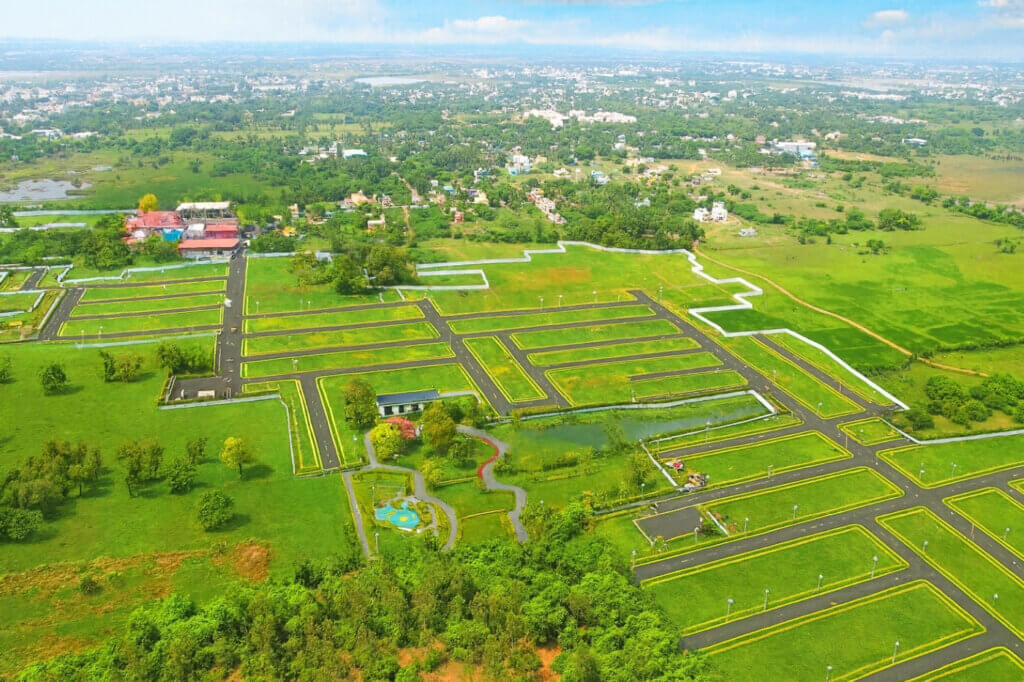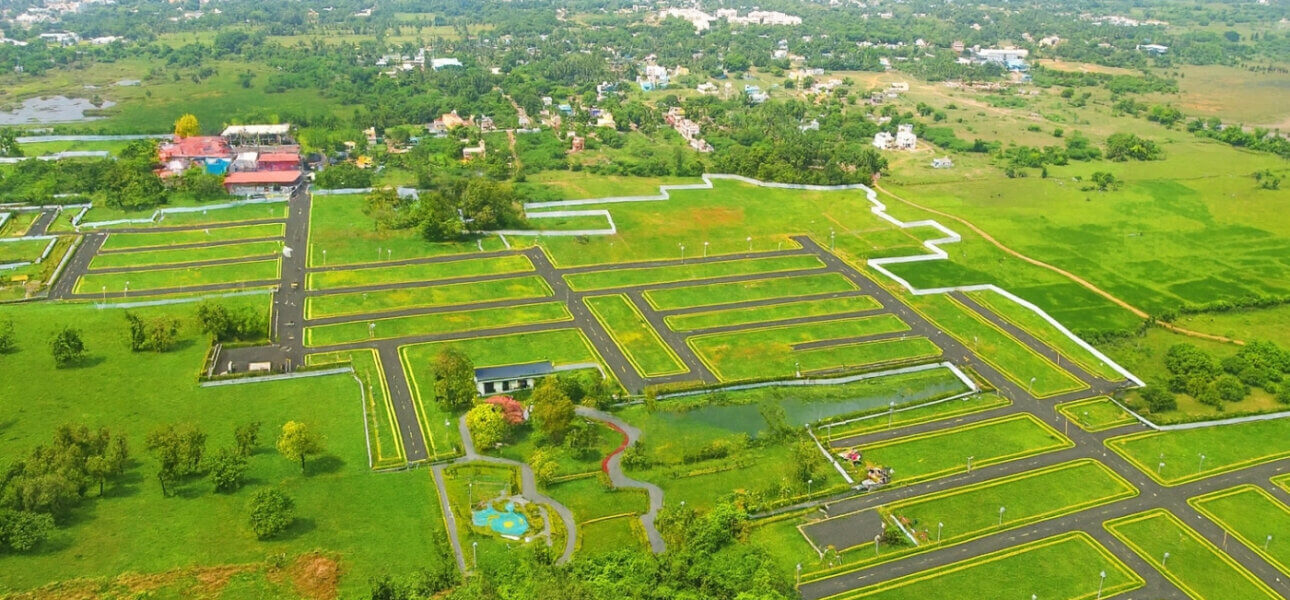A green lawn and happy trees do not always need fresh water every day. With a simple greywater setup, your home can save plenty of water and keep the garden lush. In Padappai and the Oragadam belt where summers get hot, this is a smart, sustainable habit for every villa plot owner.

What is greywater and what is not
Greywater is lightly used water from your home that still has value for plants. It usually comes from
• Bathroom wash basins
• Showers
• Bathtubs
• Washing machines
Water from kitchen sinks often contains grease and food particles. Water from toilets is not safe for garden use. These belong in a proper wastewater line and treatment system. For most homes, bathroom and laundry water are the cleanest greywater sources for lawns and trees.
Why greywater suits Padappai gardens
Padappai enjoys good rains in the monsoon months yet experiences warm months when water conservation becomes essential. With greywater, you can
• Reduce dependence on tanker or borewell water
• Lower monthly water bills
• Keep the lawn green even during summer
• Support deep root growth for fruit and shade trees
At Velammal Garden, plots and streets are planned for comfortable family living with a green outlook. Reusing greywater sits well with this lifestyle. Explore your options and get local guidance through the team at velammalgarden.com and plan your water wise landscape for the long term.
Simple greywater systems for a home
You can begin small. You can also scale up later when you build a bigger garden. Four common approaches work well for Chennai conditions.
Bucket and watering can method
The easiest start. Collect water while showering and from wash basins in a clean bucket. Use it the same day for trees and shrubs. This method builds the habit and shows you how much water your home can reuse daily.
Laundry water diversion
Route your washing machine outlet to a mulch basin near trees. Use plant friendly, low sodium detergents. Avoid bleach. Spread out laundry days so that trees receive moderate water rather than a one time flood.
Gravity fed mulch basins
Divert bathroom water through a simple strainer and a short pipe to shallow basins around trees. Fill the basins with coarse mulch such as wood chips or dry leaves. The mulch filters lint and soap, reduces odour, and feeds soil life. This is a reliable low maintenance option for villa plots.
Drip or leach line distribution
With a small filter and a settling drum, greywater can move to drip lines or perforated pipes buried under mulch. This spreads water evenly across a hedge or a lawn edge. Keep it subsurface to avoid contact.
Treatment and filtration basics
• Strain out hair and lint at the bathroom outlet
• Use a small silt trap or settling drum before distribution
• Add a simple sand and gravel filter for lawns
• Keep everything accessible for quick cleaning
Clean the strainer weekly. Rinse the filter media every month. If you notice slow flow or smell, refresh the mulch and clean the trap.
Soaps and detergents that plants like
Plants prefer soft, simple soaps. Look for laundry liquids that are low in sodium and low in boron. Choose products without chlorine bleach or optical brighteners. For bathroom use, mild soaps are better than harsh cleaners. If you must use stronger products on some days, divert water back to the sewer line and resume garden reuse the next day.
Where to use greywater in the garden
Greywater is best for deep rooted plants and trees. Ideal choices for Padappai and the Oragadam belt include
• Coconut
• Mango
• Guava
• Sapota
• Drumstick
• Neem
• Banana with extra mulch
• Hibiscus and frangipani for flowering borders
Keep the water off edible leaves and vegetables. If you want to irrigate a kitchen garden, use greywater only through subsurface drip and keep harvest hygiene in mind.
Greywater and lawns
Lawns love regular moisture but do not enjoy standing water. For Bermuda or Zoysia lawns common in Chennai, supply light doses of filtered greywater through drip or leach lines under mulch. Flush the lawn with fresh water once a week to reduce soap build up. Aerate the soil once a season to keep roots healthy.
Do and Do not checklist
Do
• Spread water across many plants rather than one spot
• Rotate which trees receive laundry water on different days
• Use mulch basins to hide odour and trap lint
• Divert away from foundations and neighbour boundaries
• Rest the system during heavy rain to avoid waterlogging
Do not
• Store greywater for more than 24 hours
• Spray greywater on leaves or edible parts
• Let greywater stagnate in open pits
• Use bleach heavy detergents
• Overwater clay soils that drain slowly
Seasonal tuning for Chennai weather
• Summer months
Increase frequency for trees during heat waves. Add fresh mulch to reduce evaporation.
• Monsoon months
Pause or reduce diversion when the ground is moist. Let soil breathe and drain.
• Post monsoon
Top dress with compost to balance any soap residue and recharge microbes.
Planning during home design
If you are building a villa at Velammal Garden, include greywater lines in your plumbing plan. A separate line from bathrooms to a small filter and a gravity distribution network is cost efficient when designed early. Plan the garden layout with mulch basins near trees, a level lawn with gentle slope, and a service corner for the settling drum. Your architect or plumber can keep pipe runs short and accessible.
Costs and care in simple terms
A basic diversion with a strainer and mulch basins is very affordable and uses low maintenance parts. A small filter barrel, a few metres of pipe, and regular mulch are usually enough for a family of four. Keep a monthly ten minute routine to clean strainers and refresh mulch where needed. This light attention keeps the system fresh and dependable.
Community and compliance comfort
DTCP and RERA approved communities value neat and sanitary surroundings. A well designed greywater system is clean, safe, and neighbour friendly. Keep your distribution below mulch, avoid open pooling, and maintain filters. If you are unsure, consult your builder or the site team for best practice. For plot planning help, visit velammalgarden.com and explore the layout, amenities, and green living ideas that fit your family.
Quick start plan for your plot
• Week one
Begin bucket reuse from shower for two trees
• Week two
Divert washing machine water to a mulch basin
• Month one
Install a small settling drum and gravel filter
• Month two
Extend to subsurface drip near the lawn edge
• Ongoing
Mulch, monitor, and enjoy a greener garden
Call to action
Water wise living starts at home. If you are choosing a plot or planning your villa in Padappai, bring greywater reuse into your garden design from day one. It saves water, builds soil health, and keeps your landscape lively through the seasons. Learn more about community ready living and plan your eco friendly home journey at velammalgarden.com.
FAQs
What is the safest source of greywater for gardens
Bathroom wash basins and showers are the safest. Laundry water is also fine when you use mild detergents. Avoid kitchen sink water and never use toilet water.
Can I use greywater on a vegetable garden
Use only subsurface delivery such as drip under mulch. Keep greywater away from edible leaves and fruits that touch the water. Wash harvests well.
Will greywater harm my lawn
Not if it is filtered and applied below mulch in light, regular doses. Flush with fresh water weekly and aerate the lawn once a season for best results.
Which trees near Chennai do well with greywater
Coconut, mango, guava, neem, sapota, drumstick, banana, hibiscus, and frangipani perform well, especially when mulch basins are used.
How do I start greywater reuse in a rented home
Begin with bucket reuse and a portable mulch basin for potted trees or a small corner of the garden. When you build your own villa at Velammal Garden, include a permanent diversion and filter in the plumbing plan.


